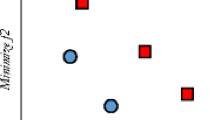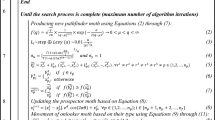Abstract
Grasshopper Optimization Algorithm (GOA) was modified in this paper, to optimize multi-objective problems, and the modified version is called Multi-Objective Grasshopper Optimization Algorithm (MOGOA). An external archive is integrated with the GOA for saving the Pareto optimal solutions. The archive is then employed for defining the social behavior of the GOA in the multi-objective search space. To evaluate and verify the effectiveness of the MOGOA, a set of standard unconstrained and constrained test functions are used. Moreover, the proposed algorithm was compared with three well-known optimization algorithms: Multi-Objective Particle Swarm Optimization (MOPSO), Multi-Objective Ant Lion Optimizer (MOALO), and Non-dominated Sorting Genetic Algorithm version 2 (NSGA-II); and the obtained results show that the MOGOA algorithm is able to provide competitive results and outperform other algorithms.









Similar content being viewed by others
References
Motevasel M, Seifi AR, Niknam T (2013) Multi-objective energy management of chp (combined heat and power)-based micro-grid. Energy 51:123–136
Elhoseny M, Tharwat A, Hassanien AE (2017) Bezier curve based path planning in a dynamic field using modified genetic algorithm. J Comput Sci, In Press
Tharwat A, Gabel T, Hassanien AE (2017) Parameter optimization of support vector machine using dragonfly algorithm. In: International conference on advanced intelligent systems and informatics. Springer, Berlin, pp 309–319
Elhoseny M, Tharwat A, Farouk A, Hassanien AE (2017) K-coverage model based on genetic algorithm to extend wsn lifetime. IEEE Sensors Lett 1(4):1–4
Handl J, Kell DB, Knowles J (2007) Multiobjective optimization in bioinformatics and computational biology. IEEE/ACM Trans Comput Biol Bioinform 4(2):279–292
Kipouros T, Jaeggi DM, Dawes WN, Parks GT, Savill AM, Clarkson PJ (2008) Biobjective design optimization for axial compressors using tabu search. AIAA J 46(3):701
Tharwat A, Gabel T, Hassanien AE (2017) Classification of toxicity effects of biotransformed hepatic drugs using optimized support vector machine. In: International conference on advanced intelligent systems and informatics. Springer, Berlin, pp 161–170
Hassanien AE, Tharwat A, Own HS (2017) Computational model for vitamin d deficiency using hair mineral analysis. Comput Biol Chem 70:198–210
Rizk-Allah RM, Hassanien AE (2017) A hybrid optimization algorithm for single and multi-objective optimization problems. In: Handbook of research on machine learning innovations and trends. IGI Global, Hershey, pp 491–521
Marler RT, Arora JS (2004) Survey of multi-objective optimization methods for engineering. Struct Multidiscip Optim 26(6):369–395
Deb K (2012) Advances in evolutionary multi-objective optimization. In: Search based software engineering, pp 1–26
Coello CAC (2009) Evolutionary multi-objective optimization: some current research trends and topics that remain to be explored. Front Comput Sci Chin 3(1):18–30
Coello CAC, Lamont GB, Van Veldhuizen DA et al (2007) Evolutionary algorithms for solving multi-objective problems, 2nd edn. Springer, Berlin
Padhye N, Mittal P, Deb K (2015) Feasibility preserving constraint-handling strategies for real parameter evolutionary optimization. Comput Optim Appl 62(3):851–890
Coello CC (2006) Evolutionary multi-objective optimization: a historical view of the field. IEEE Comput Intell Mag 1(1):28–36
Padhye N, Bhardawaj P, Deb K (2013) Improving differential evolution through a unified approach. J Glob Optim 55(4):771
Deb K, Padhye N (2014) Enhancing performance of particle swarm optimization through an algorithmic link with genetic algorithms. Comput Optim Appl 57(3):761–794
Srinivas N, Deb K (1994) Muiltiobjective optimization using nondominated sorting in genetic algorithms. Evol Comput 2(3):221–248
Deb K, Pratap A, Agarwal S, Meyarivan T (2002) A fast and elitist multiobjective genetic algorithm: Nsga-ii. IEEE Trans Evol Comput 6(2):182–197
Zitzler E, Thiele L (1999) Multiobjective evolutionary algorithms: a comparative case study and the strength Pareto approach. IEEE Trans Evol Comput 3(4):257–271
Coello CAC, Pulido GT, Lechuga MS (2004) Handling multiple objectives with particle swarm optimization. IEEE Trans Evol Comput 8(3):256–279
Padhye N, Branke J, Mostaghim S (2009) Empirical comparison of mopso methods-guide selection and diversity preservation. In: IEEE congress on evolutionary computation (CEC’09). IEEE, New York, pp 2516–2523
Padhye N (2009) Comparison of archiving methods in multi-objectiveparticle swarm optimization (mopso): empirical study. In: Proceedings of the 11th annual conference on genetic and evolutionary computation. ACM, New York, pp 1755–1756
Zhang Q, Li H (2007) Moea/d: a multiobjective evolutionary algorithm based on decomposition. IEEE Trans Evol Comput 11(6):712–731
Abbass HA, Sarker R, Newton C (2001) Pde: a Pareto-frontier differential evolution approach for multi-objective optimization problems. In: Proceedings of the 2001 congress on evolutionary computation, vol 2. IEEE, New York, pp 971–978
Wolpert DH, Macready WG (1997) No free lunch theorems for optimization. IEEE Trans Evol Comput 1(1):67–82
Saremi S, Mirjalili S, Lewis A (2017) Grasshopper optimisation algorithm: theory and application. Adv Eng Softw 105:30– 47
Haupt RL, Haupt SE (2004) Practical genetic algorithms. Wiley, New York
Zhang Q, Zhou A, Zhao S, Suganthan PN, Liu W, Tiwari S (2008) Multiobjective optimization test instances for the cec 2009 special session and competition. University of Essex, Colchester, UK and Nanyang Technological University, Singapore, special session on performance assessment of multi-objective optimization algorithms, technical report 264
Ščap D, Hoić M, Jokić A (2013) Determination of the Pareto frontier for multiobjective optimization problem. Transactions of FAMENA 37(2):15–28
Kim IY, de Weck OL (2005) Adaptive weighted-sum method for bi-objective optimization: Pareto front generation. Struct Multidiscip Optim 29(2):149–158
Das I, Dennis JE (1998) Normal-boundary intersection: a new method for generating the Pareto surface in nonlinear multicriteria optimization problems. SIAM J Optim 8(3):631–657
Parsopoulos KE, Vrahatis MN (2002) Particle swarm optimization method in multiobjective problems. In: Proceedings of the 2002 ACM symposium on applied computing. ACM, New York, pp 603–607
Deb K (2011) Multi-objective optimisation using evolutionary algorithms: an introduction. In: Multi-objective evolutionary optimisation for product design and manufacturing. Springer, Berlin, pp 3–34
Goldberg D (1989) Genetic algorithms in optimization, search and machine learning. Addison-Wesley, Reading
Tharwat A, Gaber T, Hassanien AE, Elnaghi BE (2017) Particle swarm optimization: a tutorial. In: Handbook of research on machine learning innovations and trends. IGI Global, Hershey, pp 614–635
Nebro AJ, Durillo JJ, Coello CAC (2013) Empirical comparison of mopso methods-guide selection and diversity preservation. In: IEEE congress on evolutionary computation (CEC). IEEE, New York, pp 3153–3160
Knowles J, Thiele L, Zitzler E (2006) A tutorial on the performance assessment of stochastic multiobjective optimizers. Tik Report 214:327–332
Pradhan PM, Panda G (2012) Solving multiobjective problems using cat swarm optimization. Expert Syst Appl 39(3):2956–2964
Shi X, Kong D (2015) A multi-objective ant colony optimization algorithm based on elitist selection strategy. Metallurgical & Mining Industry 7(6):333–338
Hancer E, Xue B, Zhang M, Karaboga D, Akay B (2015) A multi-objective artificial bee colony approach to feature selection using fuzzy mutual information. In: IEEE congress on evolutionary computation (CEC). IEEE, New York, pp 2420–2427
Hemmatian H, Fereidoon A, Assareh E (2014) Optimization of hybrid laminated composites using the multi-objective gravitational search algorithm (mogsa). Eng Optim 46(9):1169–1182
Velazquez JMO, Coello CAC, Arias-Montano A (2014) Multi-objective compact differential evolution. In: IEEE symposium on differential evolution (SDE). IEEE, New York, pp 1–8
Yamany W, El-Bendary N, Hassanien AE, Emary E (2016) Multi-objective cuckoo search optimization for dimensionality reduction. Procedia Computer Science 96:207–215
Emary E, Yamany W, Hassanien AE, Snasel V (2015) Multi-objective gray-wolf optimization for attribute reduction. Procedia Computer Science 65:623–632
Lin W, Yu D, Wang S, Zhang C, Zhang S, Tian H, Luo M, Liu S (2015) Multi-objective teaching–learning-based optimization algorithm for reducing carbon emissions and operation time in turning operations. Eng Optim 47(7):994–1007
Coello CA (2000) An updated survey of ga-based multiobjective optimization techniques. ACM Comput Surv (CSUR) 32(2):109–143
Pareto V (1964) Cours d’économie politique, vol 1. Librairie Droz
Mirjalili S (2016) Dragonfly algorithm: a new meta-heuristic optimization technique for solving single-objective, discrete, and multi-objective problems. Neural Comput Applic 27(4):1053–1073
Van Veldhuizen DA, Lamont GB (1998) Multiobjective evolutionary algorithm research: a history and analysis. Tech. rep., Technical Report TR-98-03, Department of Electrical and Computer Engineering, Graduate School of Engineering, Air Force Institute of Technology, Wright-Patterson AFB Ohio
Coello CC, Pulido GT (2005) Multiobjective structural optimization using a microgenetic algorithm. Struct Multidiscip Optim 30(5):388–403
Sadollah A, Eskandar H, Kim JH (2015) Water cycle algorithm for solving constrained multi-objective optimization problems. Appl Soft Comput 27:279–298
Tharwat A, Hassanien AE, Elnaghi BE (2016) A ba-based algorithm for parameter optimization of support vector machine. Pattern Recogn Lett 93:13–22
Tharwat A, Elnaghi BE, Hassanien AE (2016) Meta-heuristic algorithm inspired by grey wolves for solving function optimization problems. In: International conference on advanced intelligent systems and informatics. Springer, Berlin, pp 480–490
Mirjalili S, Jangir P, Saremi S (2017) Multi-objective ant lion optimizer: a multi-objective optimization algorithm for solving engineering problems. Appl Intell 46(1):79–95
Schott JR (1995) Fault tolerant design using single and multicriteria genetic algorithm optimization. Tech. rep., DTIC Document
Deb K (2001) Multi-objective optimization using evolutionary algorithms. Wiley, Chicheter
García S, Fernández A, Luengo J, Herrera F (2010) Advanced nonparametric tests for multiple comparisons in the design of experiments in computational intelligence and data mining: experimental analysis of power. Inform Sci 180(10):2044–2064
Zitzler E, Deb K, Thiele L (2000) Comparison of multiobjective evolutionary algorithms: empirical results. Evol Comput 8(2):173–195
Tanaka M, Watanabe H, Furukawa Y, Tanino T (1995) Ga-based decision support system for multicriteria optimization. In: IEEE international conference on systems, man and cybernetics. Intelligent systems for the 21st century, vol 2. IEEE, New York, pp 1556–1561
Binh TT, Korn U (1997) Mobes: a multiobjective evolution strategy for constrained optimization problems. In: The third international conference on genetic algorithms (Mendel 97), vol 25, p 27
Osyczka A, Kundu S (1995) A new method to solve generalized multicriteria optimization problems using the simple genetic algorithm. Struct Multidiscip Optim 10(2):94–99
Kita H, Yabumoto Y, Mori N, Nishikawa Y (1996) Multi-objective optimization by means of the thermodynamical genetic algorithm. In: Parallel problem solving from nature—PPSN IV, pp 504–512
Tharwat A, Hassanien AE (2017) Chaotic antlion algorithm for parameter optimization of support vector machine. Appl Intell 1–17, In Press
Author information
Authors and Affiliations
Corresponding author
Rights and permissions
About this article
Cite this article
Tharwat, A., Houssein, E.H., Ahmed, M.M. et al. MOGOA algorithm for constrained and unconstrained multi-objective optimization problems. Appl Intell 48, 2268–2283 (2018). https://doi.org/10.1007/s10489-017-1074-1
Published:
Issue Date:
DOI: https://doi.org/10.1007/s10489-017-1074-1




